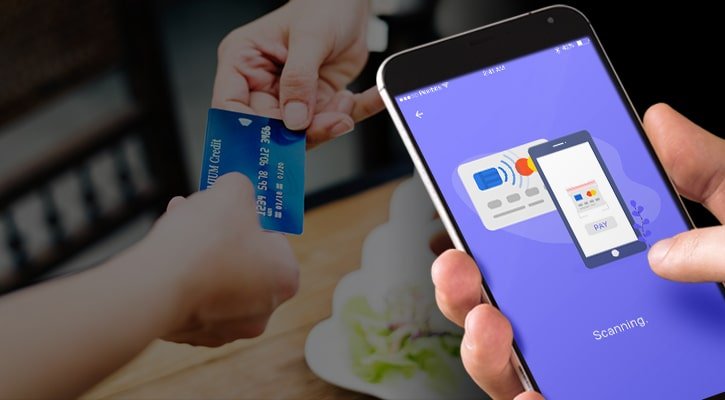
Contactless payments have been thrust into the spotlight as a result of the ongoing pandemic. While cash continues to dominate economies across the world, the transition to digital payments is taking place gradually. It is relatively faster and is quickly becoming a preferred means of payment, owing to the convenience and hygienic concerns.
NFC mobile payments are quick, secure, and simple. As a result, they have become the most widely used method of accepting in-person payments. By the end of 2020, the value of mobile payments will have surpassed half a trillion dollars.
There is no end to the rise of NFC (near field communication) payments, which is why there is no better moment to adopt mobile payment technology.
This article will show you all you need to know about this technology, from taking mobile payments to the future of NFC.
What is an NFC mobile payment?
Near-field communication (NFC) allows a card or mobile device to communicate wirelessly with card terminals and other payment equipment. If your credit card has a signal-like symbol on it, it has NFC functionality, and you can pay with it simply by tapping it on a compatible card reader.
A number of digital wallet app development organisations have developed NFC payment types that allow a buyer to complete a transaction using their mobile phone in addition to NFC-enabled credit cards.
NFC payments have gained in popularity since the coronavirus epidemic since they are a completely contactless means of payment. In fact, in-store NFC mobile payment usage grew by 29% in 2020, according to experts, and by 2025, more than half of all smartphone users in the US – 125 million people – would be utilising one or more of them. The global mobile market is anticipated to be valued at more than $3 trillion by 2024.
How Does NFC Work?
NFC is built on the same technology like RFID, which uses radio waves to send and receive data. NFC is distinguished by the use of a new set of wireless communication protocols and the use of a single frequency of 13.56 MHz.
Both NFC devices must be within 1 or 2 inches of one other to connect and initiate data transmission. When the devices “pair,” the data is encrypted for maximum security and sent to the receiving device through electromagnetic fields. It’s likely that the receiver will have to send the encrypt data back and repeat the send-receive process until the data transfer (transaction) is complete.
All of this takes only a few seconds, which is why many businesses accept payments via NFC. Customers, on the other hand, adore NFC since it allows them to purchase everything they require without having to stand in line to pay in cash and wait for a change.
NFC supports the following operations based on the situation:
- The first is peer-to-peer, which allows data to be sent in both directions between two devices. During NFC transactions, smartphones employ peer-to-peer mode.
- The second mode, read/write only, depicts a one-way communication architecture. One device serves as the transmitter and the other as the receiver in this mode.
- Card emulation is the last mode, in which an active NFC device functions as a smart card that may be tap into an NFC terminal.
NFC mobile payment apps
When it comes to NFC mobile payment apps, consumers have a few alternatives. If you want to utilise one for yourself, think about the mobile device you have or the different digital wallets you use on a regular basis.
Apple Pay
Apple Pay was introduce in 2014, and with the introduction of the iPhone 6, it has enable contactless payments on all iPhones and Apple Watches. It includes a Touch ID mechanism as well as tokenisation (no credit card information is transmit), making it one of the most secure contactless payments.
Google Pay
Google Pay, formerly known as Android Pay, is now accessible on both Android and iOS smartphones. And boasts 25 million monthly active users in the United States, making it the No. 2 digital wallet in the country.
It has a number of services that assist users in keeping track of their spending. It is mostly use in the United States and India.
LifeLock Wallet
Lifelock is a well-known identity theft protection company that has just released its own digital platform, Lifelock Wallet. It also allows you to preserve card data, insurance, and other card information while also protecting your device.
It is capable of scanning hundreds of transactions per second in order to discover and alert users to any type of threat or fraud. In the unusual circumstance of identity theft, a restoration specialist will come to your aid.
Benefits of accepting NFC payments
If you’ve ever wondered why NFC payments are so popular, it’s because of their major benefits. They outperform both Bluetooth and EMV in terms of speed, convenience, and security. But, let’s take a deeper look at the benefits of accepting NFC payments.
More Convenient
It is quite handy to pay using mobile wallets. Bring your phone close to an NFC reader (such as a terminal) and tap it to pay. NFC payments also consume less power, allowing you to use this technology in passive devices such as tags without turning them on.
Rapid Payments
NFC payments are quick because they don’t necessitate communication and verification between the transmitting and receiving devices as EMV transactions do. After tapping on your phone, money is sent from your phone to the receiver in a matter of seconds. When compared to EMV transactions, this enables substantially faster transactions.
And, if you deal with a large number of people and don’t want to see lineups in front of the counter, speed is everything. Furthermore, faster payments result in more sales!
Completely Secure
As stated, NFC payments employ a variety of security mechanisms to ensure secure payments. Before transmitting the data to the recipient device, mobile wallets encrypt it. Some utilise traditional encryption, while others, such as Apple Pay, tokenize your bank information, rendering it useless. Furthermore, the tokens vary with each transaction, making them hard to extract.
Furthermore, before making a payment, certain mobile wallets need a fingerprint or facial ID authentication.
Deeper Customer Engagement
Accepting NFC mobile payments strengthens and deepens the bond between retailers and their consumers. This is due to the fact that they both receive what they want: simple, quick, and secure transactions.
On the one hand, clients have a higher level of trust in merchants and are more likely to return. Merchants, on the other hand, are better equip to incorporate customer loyalty programs with payment processing. Customers may, for example, redeem a coupon by just touching their phones.
Furthermore, these programmes assist merchants in gathering vital data about their customers, allowing them to assess the performance of their program and, if necessary, enhance it.
Conclusion
The convenience, safety, and ease-of-use of contactless payments will continue to win over customers and companies as consumer habits and tastes alter in a rapidly changing world. NFC is a fast, convenient, and secure method of payment that may be use by both consumers and small and mid-sized businesses.
It is true that there are certain drawbacks to NFC technology, particularly in terms of security; but, as time passes on, this technology will improve, making it more secure for payments. With its numerous advantages and innovative features, NFC mobile application development is expected to grow in popularity in the future. Don’t be surprise if accepting or making payments using contactless techniques becomes the new norm.



